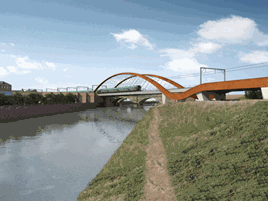On September 15 1830, the Liverpool and Manchester Railway ran its first passenger-hauling service, under fluttering pennants and surrounded by cheering crowds.
MP William Huskisson famously died after being run over by Stephenson’s Rocket on that first day of operation, making the opening a national scandal. People cowered at the idea of travelling at breakneck speeds of 25mph, but the railway age had begun, spectacularly so, and the faces of the two cities served by the line were changed forever.
At the Manchester end of the line, the station at Liverpool Road is the world’s first passenger railway terminus. It was designed to be used more as a warehouse than a station, but the building of Water Street Bridge (arguably the first modern girder bridge in the world) meant passenger facilities had to be taken into consideration.
The station is now the home of the Museum of Science and Industry (MoSI), part of the Science Museum Group.
Today the museum is capable of running short steam-hauled rides for visitors along a few hundred yards of the original Liverpool and Manchester Railway trackbed. The line stops where the tracks join the national network, but can be used to allow heritage specials or other stock to arrive at MoSI off Network Rail metals.
But all this will come to a halt if the Ordsall Chord is built. The Chord is proposed to link the line through Piccadilly with Manchester Victoria, and (for example) from 2017 trains from Yorkshire and the North East will traverse the Chord to reach Manchester Airport. There will be easier and smoother movement of trains in central Manchester and hugely improving connectivity across much of the North.
Approval of the Transport and Works Act Order was granted by Secretary of State for Transport Patrick McLoughlin in March (RAIL 772).
Work was due to start on building the Chord across the River Irwell (adjacent to Liverpool Road) in September, but this was then delayed by a legal challenge (RAIL 776). The project was already severely delayed, with its cost currently expected to be in the region of £132.7 million, according to official Network Rail documents.
However, the now-approved Chord (see pages 6-7) will cause significant damage to some of the buildings and bridges around MoSI, and will cause the line to be truncated, although MoSI will still be able to operate demonstrations.
Understandably, this is causing concern for a number of local user and heritage groups. Some believe that the balance between heritage and progress is swinging the wrong way, so can a happy medium be found?
For a short time, Mark Whitby was a consultant engineer for Network Rail on the project. He says that he resigned because Network Rail failed to consult the public properly, failed to look into alternatives to the current plan, and failed to address the issues the current plan raises.
In May, Whitby launched a legal challenge to the Ordsall Chord, delaying the project hugely in order to fight his corner.
“There is a viable alternative that will cause the delay of the development of the Middlewood Locks, but ultimately it will be for the good,” he says.
Whitby, the former president of the Institution of Civil Engineers, funded his challenge personally. He not only tried to delay the Chord’s construction, his intention was to stop it entirely - not because he is against the project to improve capacity, but because he is in favour of preserving the station at Liverpool Road. He believes that the scheme would damage unnecessarily the world’s oldest station. His alternative plan, Option 15, was suggested as a better course of action to take.
Option 15 involves the line being built higher and on a slightly tighter radius than the current Ordsall Chord scheme. Built on a more westerly alignment, it would still allow six-car trains to enter Manchester Victoria, and would (according to the plans) allow full-height bridges to be built across Liverpool Road.
This would negate the need to damage the Grade 1 listed structure of the station and railway bridges, which is what the current Ordsall Chord plan would involve.
However, the route would cross the Middlewood Locks, for which Salford Council has advanced plans for a major redevelopment. And this option would cost a further £20m, would take another five years to approve, and could cause the loss of the council’s development plans.
With this in mind, Network Rail’s position has been clear. It says: “Network Rail remains committed to delivering the benefits of the Northern Hub, which will provide space for hundreds more trains each day and room for millions more passengers. The Ordsall Chord will play a key part in enabling faster, more frequent trains and more direct services to Manchester Airport.”
NR’s stance is that the Ordsall Chord design chosen is the best for Manchester, as it is cheaper, quicker to build and quicker to bring into service than Option 15. The Department for Transport also contested Whitby’s legal challenge against the decision to allow the building of the Chord.















Login to comment
Comments
FrankH - 28/01/2016 16:01
The first sentence, last paragraph on page one says it all. Cheaper and quicker to build.